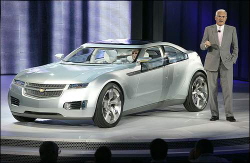It’s becoming clear that the biggest news at this years Detroit auto show was GM’s introduction of the Chevrolet Volt. I didn’t pay much attention to it myself, figuring that no matter how you look at it this introduction was a mistake. An article by Sharon Terlep in yesterday’s Detroit News suggests that at least some people inside GM thought the same thing.
 First, a bit about the Volt. It’s a concept meant to showcase technology GM might offer for sale in the 2010 to 2012 timeframe. The wheels are entirely powered by an electric motor. The battery pack stores enough energy that charging the car overnight will be sufficient for most commutes. And a small gasoline engine is onboard to recharge the batteries if this becomes necessary. So unlike with GM’s first electric car, the EV1, there’s no danger of getting stranded. And unlike, current hybrids, the gas engine cannot directly power the wheels.
First, a bit about the Volt. It’s a concept meant to showcase technology GM might offer for sale in the 2010 to 2012 timeframe. The wheels are entirely powered by an electric motor. The battery pack stores enough energy that charging the car overnight will be sufficient for most commutes. And a small gasoline engine is onboard to recharge the batteries if this becomes necessary. So unlike with GM’s first electric car, the EV1, there’s no danger of getting stranded. And unlike, current hybrids, the gas engine cannot directly power the wheels.
Existing hybrids are “parallel” hybrids. The Volt is what is known as a “series” hybrid, since the two powerplants are linked in a sequential relationship; they cannot operate in tandem. Series hybrids aren’t new. Most railroad locomotives have been series hybrids for decades. The difference in the Volt’s case: a high-capacity battery pack means that for many potential customers the gasoline engine will rarely be used.
Great concept. The only problem is that the main thing needed to make it viable–a high capacity battery pack that’s small enough to fit and cheap enough to sell–does not yet exist. It might exist in a couple years. Or it might not. GM Vice Chair Bob Lutz thinks the odds are 90 percent in favor.
Assuming the battery does happen, why show us the Volt now? No one else was showing products that will arrive in three to five years, for an obvious reason: why tip your hand to the competition so far out that they can come up with something similar in the same timeframe? The battery will come from an outside company. It will be in the best interest of this company to sell its batteries to anyone willing to pay for them.
And if the battery doesn’t happen, then GM has made a promise that will go unfulfilled.
There’s only one way the Volt might make sense to show early: GM knows other companies are working on similar products, so it’s not giving away anything by showing the car. By showing the car early, GM might get credit for the basic concept of a plug-in series hybrid. Yet no other company has stepped forward to say they’re also on the bandwagon.
So, no matter how you look at it, GM’s early intro of the Volt was a PR exercise. All that remains unknown is whether it was an expensive PR exercise–in terms of lost competitive advantage or lose credibility–or a cheap one.